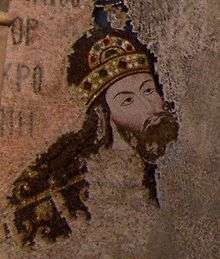Isaac Komnenos (son of Alexios I)
| Isaac Komnenos | |
|---|---|
| Sebastokrator of the Byzantine Empire | |
 Mosaic of Isaac Komnenos the Porphyrogennetos from the Chora Church | |
| Born | 16 January 1093 |
| Died | After 1152 |
| Spouse | Irene |
| Issue |
John Tzelepes Komnenos Anna Komnene Andronikos I Komnenos |
| Dynasty | Komnenoi |
| Father | Alexios I Komnenos |
| Mother | Irene Doukaina |
Isaac Komnenos or Comnenus (Greek: Ἰσαάκιος Κομνηνός, Isaakios Komnēnos; 16 January 1093 – after 1152) was the third son of Byzantine Emperor Alexios I Komnenos (r. 1081–1118) and Empress Irene Doukaina. He was raised to the high rank of sebastokrator by his older brother John II Komnenos, but they later fell out and Isaac was exiled by John for several years. During the struggle for John's succession in 1143, he supported the unsuccessful candidacy of his nephew, likewise named Isaac, over the younger Manuel I Komnenos. A few years later, he was forced to retire to a monastery by Manuel. Isaac was noted for his erudition and his patronage of learning.
Life
He was the brother of Emperor John II Komnenos and the historian Anna Komnene. Isaac was given the dignity of Caesar by his father.[1]
During and after the succession of John II in 1118, Isaac supported his elder brother against the intrigues of Empress-dowager Irene and their sister Anna, who favoured the candidacy of Anna's husband, Nikephoros Bryennios the Younger. In return, John II raised Isaac to the elevated dignity of sebastokratōr, which marked him as a near-equal to the emperor.[2] In contrast to his brother, who was chiefly engaged in warfare throughout his reign, Isaac was also a scholar and patron of learning.[3] He is known to have composed and compiled poetry, and is sometimes identified with the writer called "Isaac Komnenos the porphyrogennetos" who composed three philosophical treatises based on Proclus and two commentary works on Homer.[4]
By ca. 1130 (and possibly as early as 1122) however, John and Isaac had become estranged, and Isaac was forced to flee Constantinople with his sons for six years after an alleged conspiracy. Isaac found refuge at the court of the Danishmendid emir Gümüshtigin Ghazi II ibn Danishmend at Melitene. During this time, he also undertook a pilgrimage to the Holy Land.[2][5]
From exile, Isaac sought to create a broad alliance with other rulers against his brother, including the Seljuk Turks of Iconium, the independent prince Constantine Gabras of Trebizond, the Armenian Kingdom of Cilicia and the Latin Kingdom of Jerusalem. The coalition failed to materialize however, and he was forced to seek reconciliation with his brother in 1136.[2][5] Soon after, in 1139, Isaac's eldest son John again defected to the Turks. Either at that point or a little later, Isaac was banished as a precaution to Heraclea Pontica.[2]
Shortly before John II died in 1143, he had designated his fourth and youngest son Manuel as his heir over his third (and oldest surviving) son, the sebastokrator Isaac. Consequently, Manuel's succession was not immediately secure.[6][7] In this struggle for the throne, the elder Isaac threw his support behind the younger Isaac. However, the decisive intervention of John Axouch, the commander-in-chief of the army, was to secure the throne for Manuel. Despite his failure, in 1145–1146, according to the contemporary historian John Kinnamos, Isaac attempted to take advantage of Manuel's difficulties to usurp the imperial throne from him.[2][5]
After 1150, Manuel forced his uncle to retire from public affairs, and in 1151/1152, Isaac founded the cenobitic monastery of the Theotokos Kosmosoteira ("World-Saviour") at Bera (modern Pheres) in western Thrace. The monastery was built as his residence and final resting place; Isaac wrote the monastery's typikon himself, leaving extensive estates, including entire villages and castles to it in Thrace.[8][9] Isaac is also depicted in the Chora Church in Constantinople, which he extensively rebuilt. The Chora Church was also the initial location of Isaac's tomb, before he had it transferred to the Kosmosoteira monastery.[10]
Family
Isaac Komnenos was married to Irene, who may have been either a daughter of Volodar of Peremyshl[11] or Kata, a daughter of David IV of Georgia.[12] His children were:[13]
- John Komnenos called Tzelepes (i.e., Çelebi), became a Muslim, settled at Ikonion and married Sultan Mesud I's daughter.[14]
- unnamed daughter
- Anna Komnene, who married John Arbantenos.
- Andronikos I Komnenos, emperor 1183–1185.
Ancestry
| Ancestors of Isaac Komnenos (son of Alexios I) | |||||||||||||||||||||||||||||||||||||||||||||||||||||||||||||||||||||||||||||||||||||||||||||||||||||||||||||||||||||||||||||||||||||||||||||||||||||||||||||||||||||||||||||||||||||||||||||||||||||||||||||||||||||||||||||||||||||||||||||||||||||||||||||||||||||||||||||||||||||||||||||||||||||||||||||||||||||||||||||||||||||||||||||||||||||||||||||||||||||||||||||
|---|---|---|---|---|---|---|---|---|---|---|---|---|---|---|---|---|---|---|---|---|---|---|---|---|---|---|---|---|---|---|---|---|---|---|---|---|---|---|---|---|---|---|---|---|---|---|---|---|---|---|---|---|---|---|---|---|---|---|---|---|---|---|---|---|---|---|---|---|---|---|---|---|---|---|---|---|---|---|---|---|---|---|---|---|---|---|---|---|---|---|---|---|---|---|---|---|---|---|---|---|---|---|---|---|---|---|---|---|---|---|---|---|---|---|---|---|---|---|---|---|---|---|---|---|---|---|---|---|---|---|---|---|---|---|---|---|---|---|---|---|---|---|---|---|---|---|---|---|---|---|---|---|---|---|---|---|---|---|---|---|---|---|---|---|---|---|---|---|---|---|---|---|---|---|---|---|---|---|---|---|---|---|---|---|---|---|---|---|---|---|---|---|---|---|---|---|---|---|---|---|---|---|---|---|---|---|---|---|---|---|---|---|---|---|---|---|---|---|---|---|---|---|---|---|---|---|---|---|---|---|---|---|---|---|---|---|---|---|---|---|---|---|---|---|---|---|---|---|---|---|---|---|---|---|---|---|---|---|---|---|---|---|---|---|---|---|---|---|---|---|---|---|---|---|---|---|---|---|---|---|---|---|---|---|---|---|---|---|---|---|---|---|---|---|---|---|---|---|---|---|---|---|---|---|---|---|---|---|---|---|---|---|---|---|---|---|---|---|---|---|---|---|---|---|---|---|---|---|---|---|---|---|---|---|---|---|---|---|---|---|---|---|---|---|---|---|---|---|---|---|---|---|---|---|---|---|---|---|---|---|---|---|---|---|---|
| |||||||||||||||||||||||||||||||||||||||||||||||||||||||||||||||||||||||||||||||||||||||||||||||||||||||||||||||||||||||||||||||||||||||||||||||||||||||||||||||||||||||||||||||||||||||||||||||||||||||||||||||||||||||||||||||||||||||||||||||||||||||||||||||||||||||||||||||||||||||||||||||||||||||||||||||||||||||||||||||||||||||||||||||||||||||||||||||||||||||||||||
References
- ↑ Kazhdan (1991), pp. 1145, 1146
- 1 2 3 4 5 Kazhdan (1991), p. 1146
- ↑ Magdalino (2002), p. 194
- ↑ Kazhdan (1991), pp. 1144, 1146
- 1 2 3 Magdalino (2002), p. 193
- ↑ Kazhdan (1991), pp. 1289–1290
- ↑ Magdalino (2002), pp. 41–42, 195
- ↑ Kazhdan (1991), pp. 282–283, 1146
- ↑ Magdalino (2002), pp. 193–194
- ↑ Kazhdan (1991), pp. 282, 428, 1146
- ↑ Magdalino (2002), p. 205
- ↑ Suny (1994), p. 36.
- ↑ Kazhdan (1991), p. 1145
- ↑ The Turkish Element in Byzantium, Eleventh-Twelfth Centuries, Charles M. Brand, Dumbarton Oaks Papers, Vol. 43, (1989), 20.
Sources
| Wikimedia Commons has media related to Isaac Komnenos (son of Alexios I). |
- Kazhdan, Alexander, ed. (1991). Oxford Dictionary of Byzantium. Oxford University Press. ISBN 978-0-19-504652-6.
- Magdalino, Paul (2002). The Empire of Manuel I Komnenos, 1143–1180. Cambridge University Press. ISBN 0-521-52653-1.
- Suny, Ronald Grigor (1994), The Making of the Georgian Nation. Indiana University Press, ISBN 0253209153.
- Varzos, Konstantinos (1984). Η Γενεαλογία των Κομνηνών, Τόμος Α' [The Genealogy of the Komnenoi, Volume I]. Thessaloniki: Byzantine Research Centre.